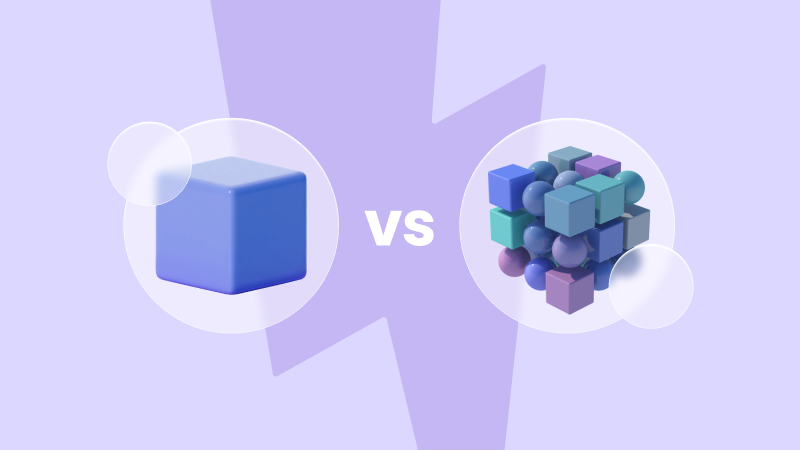What Is a Monolithic Blockchain?
Monolithic blockchains are systems where the entire blockchain is stored in a single node. Monolithic blockchains use a single database to store all the transactions on their network.
Monolithic blockchains serve as fully functional software platform that allows users to perform different tasks, such as storing and sharing information. It can be used for digital currencies, smart contracts, and decentralized ledger technology (DLT) applications. In general, monolithic blockchains are designed to work as a standalone system without requiring any additional software or hardware products to run correctly.
The main features of a monolithic blockchain are:
- It is a single, integrated system without separating the ledger and the mining process.
- It is designed to be trustless and is not based on any centralized authority or trusted third party.
- It uses consensus algorithms such as proof of work (PoW) or proof of stake (PoS).
- The ledger is publicly visible, meaning anyone can see all transactions on the blockchain.
- It uses smart contracts to automate processes and verify transactions between parties without requiring their direct participation in the network.
How Does Monolithic Blockchain Work?
The important distinction of a monolithic blockchain is that all the tasks are processed on the same layer. Here are all the steps in the working process of this kind of blockchain:
- A node receives a transaction, a signature is verified, and compliance with a consensus is verified;
- The transaction is added to a mempool or dropped if hadn’t passed the verification process;
- The transaction is added to a candidate block by a miner;
- The block can be broadcasted and added to a chain.
Advantages & Disadvantages of a Monolithic Blockchain
Several advantages are associated with using monolithic blockchains over other types of DLT networks. For example, they offer better privacy protection due to their limited size and fewer users than different types of networks like permissioned DLTs or permissionless DLTs. Additionally, monolithic blockchains tend to have more secure architectures than permissionless DLTs because they do not require third-party involvement to process transactions quickly and securely.
One of the most significant problems is scalability, which can be solved using side chains or sharding. However, these solutions require additional investment and effort from developers and users.
Another disadvantage of a monolithic blockchain is that it can become costly due to high transaction fees. This problem occurs when many people want to use the network simultaneously, and there aren’t enough miners to mine more blocks quickly enough.
Examples of Monolithic Blockchain
Bitcoin
Bitcoin is one of the most well-known examples of monolithic blockchains. It requires the execution of every node against its blockchain copies. Even though it increases decentralization, at the same time, it decreases the capacity of the blockchain.
Ethereum 1.0
Another great example is Ethereum 1.0. Its existence in a monolithic blockchain explains its low throughput and high level of security.
What Is a Modular Blockchain?
Modular blockchain is a technology that allows for the creation of multiple blockchains on one network. Each blockchain can be customized to meet the needs of specific industries, enterprises and users. This technology will allow companies to create blockchain networks with different consensus mechanisms, privacy features, and smart contracts.
The modular blockchain has many features that make it different from other blockchains. Here are some of these features:
— Easy integration with existing systems;
— Multi-chain architecture;
— Lightweight private chains;
— Smart contract library.
How Does Modular Blockchain Work?
The fundamental principle of a modular blockchain is the possibility of combining several modules to achieve certain objectives. There are different variations of modular blockchain architecture. It can be designed to deal with one or several of the following functions:
- Executive function;
- Blockchain can support transactions and interactions with smart contracts;
- Transaction data support;
- A blockchain can make sure that transaction data is available when needed;
- Consensus mechanism;
- Blockchain can also take the function of ensuring consensus;
- Settlement;
- One of the options for a part of a modular blockchain is to provide settlement, which may include finalizing transactions, validating, and settling disputes.
Advantages & Disadvantages of Modular Blockchain
The main advantage of modular blockchains is scalability. A certain scalability can be achieved if a blockchain is not trying to handle security and scalability in the same layer. Moreover, modular blockchains are highly flexible. It is easy to add new features or make some significant changes.
The main disadvantage of modular blockchains is that they may need to be more secure since they rely on several different networks. Also, modules bring in an evident complexity. The more extended the blockchain is, the more complicated its structure becomes.
Examples of Modular Blockchains
Celestia
What is Celestia blockchain? It is considered to be the first modular blockchain. Its primary focus is consensus. Celestia makes it easy for anyone to deploy their blockchain. This blockchain has an extreme ability to scale with the increasing number of users. Its security level is also rising, with more nodes joining the network. So far, it is on a testnet level. The Mainnet launch is planned after the incentivized testnet in 2023.
Ethereum
While trying to improve the capacities of the network, Ethereum outsourced some functions to rollups. It is an extension to the main blockchain that helps to create better scalability. Rollups can be added to a monolithic Layer 1 as an additional execution level of Layer 2.
The Bottom Line
Monolithic and modular blockchains both have their benefits and drawbacks. The choice of the particular type of blockchain should depend on the overall project’s needs and technical capacities. Prioritizing is the key to understanding the project’s requirements and the possible number of users.
